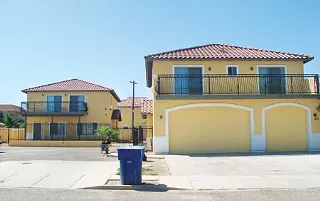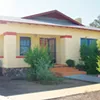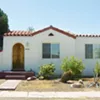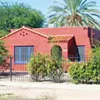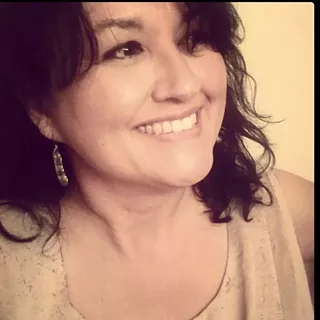In the Feldman's Neighborhood, there's an entire block on Adams Street lined with two-story stucco apartment buildings.
Welcome to Goodmanville—a historic neighborhood dotted with clusters of high-density student housing that many refer to as mini-dorms.
Michael Goodman says he's demolished dozens of single-family homes to build new apartments as a way to address the UA's need for more student housing. To him, Feldman's Neighborhood is a perfect spot to do so; it's north of campus, north Speedway Boulevard and east of Stone Avenue, a place where he's invested in rental properties since the early 1970s.
Neighbors say his student housing has come at a big price. They say he's effectively destroyed parts of their neighborhood and has refused to address neighborhood concerns—and has went so far as to file lawsuits against the city to defend his property rights.
Goodman first sued in 2006 after the city issued a stop-work order on a seven-parcel development off Elm Street, between Third and Fourth avenues. Instead of looking at the project as a series of single-family residences, the city told Goodman that the project needed to be addressed as one large development because of its size.
The court sided with the city, and the large stretch of property remains undeveloped and fenced off. Behind this vacant land, however, is a series of completed Goodman developments on Lee and Drachman streets, and then there's that entire block on Adams Street. There's only one exception in that block, an owner-occupied house that stands like a lone sentry between two towering mini-dorms. (An owner of that house refused to comment.)
Litigation between Goodman and the city continues. He filed a second lawsuit in 2007 regarding changes in Tucson's demolition code which could have prevented Goodman from immediately tearing down properties. Goodman won that case, and the nonprofit Goldwater Institute agreed to help him with litigation to test the waters for the Private Property Rights Protection Act, which voters passed as Proposition 207 in November 2006. The law requires governments to compensate landowners if new regulations decrease property values.
On Monday, Aug. 31, as the Tucson Weekly was getting ready to head to press, the Goldwater Institute and Goodman were expected in Pima County Superior Court to ask the court to force the city to pay restitution, because the demolition delay has cost Goodman thousands of dollars.
And Tucson taxpayers can expect even more litigation from the Goldwater Institute. Lawyers with the conservative public-policy organization say they plan to head back to court to challenge a design manual that's expected to go before the mayor and City Council for final approval in October.
Feldman's Neighborhood Design Manual is a project that city planners have worked on with residents and developers to find a solution that will allow developers to continue building while offering protections to homeowners who wish to protect the historic character of the area. Goodman and other developers were on the manual's planning committee, but resigned as the project was completed, saying it didn't offer developers enough incentives and would make projects too costly.
At an Aug. 13 public hearing in front of zoning examiner Peter Gavin, Goodman said the design manual violates his property rights and that the city could face a $44 million lawsuit as a result of Prop 207. At the hearing, Goodman said he's been developing student housing since 1973 and now has 36 properties in Feldman's, and another 15 in adjacent neighborhoods.
Goodman told Gavin that if the design manual is enacted, current land owners will lose. Eighty percent of the neighborhood is made up of rental properties, and many of the landlords aren't aware of how the manual's regulations will damage the value of their properties, he said.
When asked if the manual prevents him from developing his property, Goodman said it doesn't, but that it would cost him more.
"The only way (the lots) are going to get redeveloped is you have to be able to make a profit on them ... At this time, the going rate for bedrooms in a nice place is about $700 a bedroom. I have rentals that are $4,000 a month, $5,000 a month (per lot)," Goodman said at the hearing.
This is why his properties add value to the neighborhood: Investors can earn more with student housing. The manual's restrictions will take away from that value, and that's why he anticipates another lawsuit, he said.
"I don't know how the city is going to get around it," he said.
Neighbors who complain that he is destroying historic property are misguided, according to Goodman. The older adobe homes in the neighborhood are "not contributing to anything except the blight in that area.
"Realistically, you have to acknowledge there are a certain number of homes that are truly worth saving as good examples of historic development, but the majority of them are not."
For more than 46 years, Canara Price has lived in one of those old adobe homes. Price arrived with her husband in Tucson in the '60s, bringing with her with a teaching degree, years of memories of growing up in the Mississippi Delta, and sons getting ready for high school and college.
She says she found herself right at home in the old adobe house, in the middle of a close-knit neighborhood where everyone knew their neighbors.
Back then, the streets surrounding her house were part of what many still call Sugar Hill, a predominately African-American community that grew around rows of houses given to African-American veterans who served in World War II.
Price's house is filled with decades of memories, including numerous pictures of her family and friends. On the top of a bookshelf is a large black-and-white college-graduation portrait of her; it's right next to her diploma, framed and prominently displayed.
Price laughs easily, and her eyes have a sparkle under her black-framed glasses. Despite her graying hair and her slow, cane-aided gait, Price doesn't look like someone who is 96 years old.
"If I had to live over, I'd want the same parts, the same four sons and the same husband," Price says, beaming.
"Really, you'd do it all again, and not change anything?" asks neighbor Kathleen Williamson.
"Yes. That's right," Price answers.
She'd even pick the same house, she says, as she slowly walks through the master bedroom to step onto her back porch. Not long ago, like most of her neighbors, Price had a full, unobstructed view of the Santa Catalina Mountains. However, the view now includes a two-story yellow stucco building with a garage on the bottom, a large balcony jetting from the top floor, and a green clay-tiled roof.
"I can live with this for a few years," Price declares, joking about her advanced age.
Her home will one day be inherited by her sons and grandchildren, who will have to make a decision about what to do with it. Williamson, who bought her house—across the street from Price's home—in 1991 when she was completing her doctorate at the UA, smiles at Price, but is quick to remind her to tell her family to talk to her before they think of selling to Goodman.
Price and Williamson settle into chairs near a piano that sits in the room that once belonged to Price's youngest son. Price looks over at Williamson, a local attorney and musician who has taken care of Price when she's needed help around the house or company. Together, they talk about old neighbors who have passed away—so many over the years that the neighborhood is no longer predominately African-American.
The neighborhood was once mostly owner-occupied, but is now about 80 percent renters. Williamson says she feels lucky that she bought her house while many of the aging African-American residents were still alive. She forged a lot of friendships back then.
Price's husband died in 1990. She says Williamson moved into the neighborhood at just the right moment. Williamson takes Price to parties where Williamson and her friends play music, even inviting Price to join in on piano and sing.
"There's a party at my friend Darwin's tonight, and you're invited to come with me. Can I pick you up at 5?" Williamson asks her friend.
They make plans, this tall, redheaded woman with a hint of a New York City accent, and this 96-year-old African-American woman raised in the Mississippi Delta.
Williamson admits she wonders who will be around to offer her help as she gets older. Worse, Williamson says, she wonders if she'll wake up one day to the sounds of a demolition next door.
"That's how neighbors find out he's building. The house sells, and then a little later, without warning, it's taken down," she laments.
Williamson's house is her retirement pad. She's only a few years away from paying off her mortgage, but if her property ends up surrounded by Goodman buildings, she's certain it will have little value as an owner-occupied house.
Price is more optimistic about Williamson's future.
"You reap what you sow," she says, smiling at Williamson.
Diana Lett, vice president of the Feldman's Neighborhood Association, says she wonders the same things as Williamson. She and her partner have lived in their home for 22 years and regularly help out their 85-year-old neighbor. She and other neighborhood-association members have been walking a fine line: They've been trying to slow down Goodman, while at the same time encouraging him to look at other areas in the neighborhood that are vacant and along large arterials—perfect for the dense student housing he wants to build.
"Large-scale developers like Mike Goodman like to frame this story as the old NIMBY neighbors against the university. That's not how it is," Lett says. "Most of the owner-occupieds like us have some connection to the university. And most of us have lived quite harmoniously with students this entire time."
Neighbors say Goodman's buildings are party houses, with festivities often lasting well past 2 a.m. They encourage each other to call the police and have worked hard to help the police red-tag apartments as often as possible. Some of those calls, however, have led to retaliation from the students and have made some neighbors scared to call in complaints.
Lett says the problems partially have to do with Goodman's design and his insistence on building high-density clusters. That means there are often three to four buildings on each parcel.
"Having a cluster of buildings that clearly do not fit into the neighborhood is a problem, and may, in fact, encourage what I call the 'spring break at Rocky Point mentality': 'We can do anything and get away with it.' It very well may be an issue with the architecture, because we've noticed that when his buildings are built in isolation (a single building on one parcel), there isn't that kind of behavioral problem from the students," Lett says.
What's also troubling to Lett is Goodman's defense of his developments—that he is filling a need for student housing.
"Developers have created this false dichotomy that the neighborhood isn't as important as the needs of the UA, even though UA officials have gone on record repeatedly saying they support historic neighborhoods and their preservation. It's a straw man, because the reality is that what we have in Tucson is an embarrassment in riches of sites that are well-suited for development of student housing."
Lett has put together a list of properties in Feldman's Neighborhood that are distressed commercial properties and vacant lots on neighborhood arterials.
"We've got two huge vacant lots on Speedway (Boulevard): one at the corner of Stone (Avenue) and Speedway (Boulevard), and another nearby—one is almost an entire city block. Of course, it's cheaper to buy up residential properties from older people that don't know they should ask for more."
Lett says there are some property owners who want to sell their homes—but are opposed to selling them to Goodman. She claims Goodman has used other people to do the negotiations for him, before coming in at the last minute.
"If people urgently need to sell their house, even if they are not too pleased, they have no choice at that point but to go along with it. That's how he's bought a number of properties," Lett says.
The claim by Goodman at the Aug. 13 hearing that the majority of properties in Feldman's are not historic or worth saving—especially considering there's a need for student housing—troubles Lett, too.
"Well, that's just absurd; there's no conflict there," she says. "There's room for development; there's room for historic preservation, and those two goals don't have to be in conflict. He says infill-incentive-district properties are totally unacceptable to him, because they are too far from the UA—three blocks further from the UA than his properties. ... Here's the thing: They are directly across the street from Pima Community College. To say there is nothing appropriate there for student housing is just a lie, pure and simple."
After the Tucson Weekly left a message at his leasing office and then sent him an e-mail, Goodman responded by e-mail, saying that he wasn't sure about an interview.
"I am very reluctant to meet with you because it is my opinion that your magazine is both left-leaning and has published erroneous and biased information about me and the issues of infill in the UA area. If you would agree to: (a) submit your questions to me in writing, and (b) publish all your questions verbatim and all my written responses both verbatim and immediately following the appropriate question, then I would consider cooperating via this format. This should (ensure) a truer presentation to your readers of the questions, the context, and the answers. However, I doubt that a more truthfully didactive article is what you or your publication is seeking," Goodman wrote.
After Goodman was told the Weekly would not agree to those terms, he wrote: "While I am very reluctant to meet with you for matters previously stated, I sincerely feel that the citizens of Tucson should be made aware of the millions of dollars of potential liability that the city of Tucson will be subjecting itself to and which will likely be coming from the citizens' pockets if the Feldman's Design Manual is adopted.
"The value of most of these properties for redevelopment under the current zoning code is higher than the value for the housing that now exists. If this is not true, I and others wouldn't be buying, tearing existing houses down and building larger units which bring in greater rents. Passage of the design ordinance will eliminate the ability to build these larger units and will therefore eliminate the higher value that these properties can now command for redevelopment purposes. ... The days of the city's bullying property owners and overstepping private ownership rights with impunity are over. I and others have spent much hard-earned money in defending our property rights and the rights of others and will continue to do so regardless of cost.
"Some of your readers owning property in Feldman's will probably want to join the class-action lawsuit that will undoubtedly arise if the Feldman's Design Manual is adopted. Almost 80 percent of Feldman's property owners are investors who use their property for rental income and will be adversely affected if this ordinance is adopted."
Goodman then agreed to be interviewed over the phone.
"Nobody bought a house and woke up, and said, 'Oh my gosh, there's a university here,'" he says. "Seventy-eight percent of the current property owners bought their property for investments. The real issue is the students. But where are students suppose to live?"
Goodman says that he's done a lot of good for the neighborhood, throwing out drug dealers and prostitutes and creating new rentals that give students a choice.
"What I build are luxury apartments these students want, (with) granite counters in the kitchens (and) nice bathrooms," Goodman says. "I did not create the demand; the demand was already there."
After talking briefly, Goodman said he had to go into a meeting and would call back, but he never did.
When Leslie Robinson Jr. sits down to talk about the changes taking place in the surrounding neighborhoods, he pauses for a moment. His eyes well up with tears, and he stops talking to catch his breath.
Williamson reaches out and touches his shoulder.
"I'm so sorry, Mr. Robinson," she says.
He shakes his head back and forth, then smiles. His wife, Mary, sits across from him at a table in the social hall of Mount Olive Church of God in Christ, a small church on Lee Street steeped in African-American traditions.
Right next door is a building on a lot once owned by the city that the church used for parking. When the city decided to take bids on the property several years ago, Robinson says, the church put in a bid, but the city accepted Goodman's offer instead.
"There was still land between us, and we found out we could file a quitclaim to get it, and when we tried, we found out Mr. Goodman had just filed to get the rest of that property," Robinson says, referring to a utilities easement.
"He put a fence along the property right away, and when we asked him if we could work out a deal to use it for parking, he told us he could probably work out a deal with us for $500 a month."
Memories of the transaction still stings, Robinson says. Many people in his congregation remain upset that the city didn't consider their bid.
The congregation, founded by Mary's father in 1927, isn't the same as it used to be, but the Robinsons say UA students and families from Davis-Monthan Air Force Base find the church and join the congregation for services every Sunday.
The Robinsons say that when they first met with Goodman to talk about the property, he told them he didn't have much use for Jesus.
"We still pray for (Goodman) anyway," Robinson says, smiling.
After Williamson and I leave the church to walk to her home, the jets from Davis-Monthan fly overhead, making it difficult to talk for several moments.
"Before Michael Goodman, that used to be my biggest issue. ... We did put enough pressure on those guys, (and the jets) are not as bad as they used to be. Then this Goodman thing came," Williamson says.
Williamson recalls a neighbor, Mrs. George, who passed away a few years ago. Her son put her house up for sale, while Goodman began to build the apartments next to the Mount Olive church. The house sat unsold for months, and eventually, the son had no choice but to sell to Goodman.
"The reason it didn't sell was because when he built that monstrosity right next door to the church, everybody knew what could happen next," Williamson says.
The biggest cluster of Goodman's properties is a block from her house. At night, she can hear the parties through her bedroom window, she says. When she walks by the buildings, her heart breaks as she thinks about what used to be there—small homes on large lots with a variety of vegetation and wildlife.
"It's a monoculture out here of alcoholic white male undergrads. I've lived here since 1991, and this neighborhood was better and safer before," she says.
The Feldman's Neighborhood Design Manual, which provides a list of do's and don'ts for developers like Goodman, is scheduled go before the City Council in October.
Gavin, the zoning examiner who heard the public testimony at the Aug. 13 meeting, formally approved the design manual on Aug. 25.
Will Goodman's threats to sue determine how the City Council will vote?
According to City Councilwoman Karin Uhlich, of Ward 3, in which most of Feldman's Neighborhood sits, the city can't decide how to vote based on threats.
"But we want to make sure we're in compliance with Prop 207. So far, this new law has been untested in the courts, and the way I see it, it is subject in some respects to interpretation on both sides.
"What does need to be addressed is this issue of student housing and protecting historic and single-family residential neighborhoods. We really are trying to approach it with a number of strategies," Uhlich says.
She agrees with Feldman's residents like Lett who say that developers need to look at land along major corridors to accommodate the growing student population. She also says putting high-density apartments on land zoned for single-family residential isn't in the spirit of that zoning.
"I think the mayor and council is willing to take a stand as long as that stand is on solid ground, based on the understanding of what the law is. That's really the issue for me—to not get caught up in a fearful approach or an aggressive approach. I don't think it's about picking a fight just because we're upset that people are developing their properties. I think what we're doing is really trying to form (new guidelines) that can stand up in court."
Goldwater Institute attorney Clint Bolick says the design manual is a good example of the value of Prop 207. So far, he says, Tucson is the only city involved in Prop 207 litigation in the state.
"Right now, the value of Goodman's property largely is made up of his right to construct much more valuable structures. ... If the community wants to limit growth and development, and that diminishes property values in the process, who should pay for that?" Bolick asks.
Lett says that's a very good question. She offers another example of diminishing property values: When a neighbor decided to retire, she put her house up for sale, and it was listed at $220,000. The final price she received was $178,000.
"This was in 2005, before prices tanked," she says. "The difference was solely attributable to the buyers finding out that one of Mr. Goodman's duplexes was going to be built next door.
"This was her retirement savings," Lett says. "It was bad news for her and bad news for all of us. We've learned that about 20 percent of property value can be lost if he builds next door to you."

